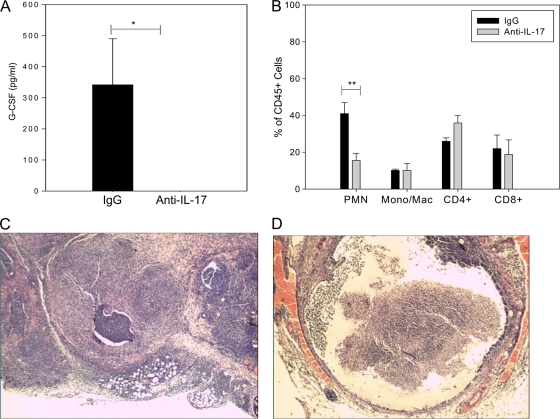FIG. 12.
Administration of anti-IL-17 to ifnγ−/− mice significantly reduces G-CSF and the number of neutrophils in the oviducts but does not improve pathology. Groups of five ifnγ−/− mice infected intravaginally with C. muridarum and treated with IgG2a or anti-IL-17 were sacrificed on day 21 postinfection, and the oviducts were harvested. (A) G-CSF was completely abrogated by IL-17 neutralization (*, P < 0.05 by Student's t test). The bars represent the means and standard errors of the mean (SEM) of values from 5 mice per group in a single experiment. (B) Percentages of live neutrophils (Ly6G [1A8]+ Gr-1high), macrophages (Mac) (F4/80+), CD4+ T cells (CD3+ CD4+ CD8−), and CD8+ T cells (CD3+ CD4− CD8+) were determined by flow cytometry. A 65% reduction in the frequency of neutrophils was noted in the anti-IL-17-treated group compared with IgG2a-treated mice on day 21 (**, P < 0.01 by ANOVA). The data points represent the means and SD of values from 5 mice per group in a single independent experiment. Mono, monocytes. (C and D) Oviducts were harvested from the IgG2a-treated (C) and anti-IL-17-treated (D) groups and examined histologically. Oviduct pathology was not improved by anti-IL-17 treatment; severe inflammation and oviduct dilatation, along with destruction of mucosal epithelial cells, granuloma formation, and a marked inflammatory exudate, were noted in both groups. The photomicrographs are representative tissue samples from the oviducts of the IgG2a-treated (C; magnification, ×40) and anti-IL-17-treated (D; magnification, ×40) groups on day 21 postinfection.

